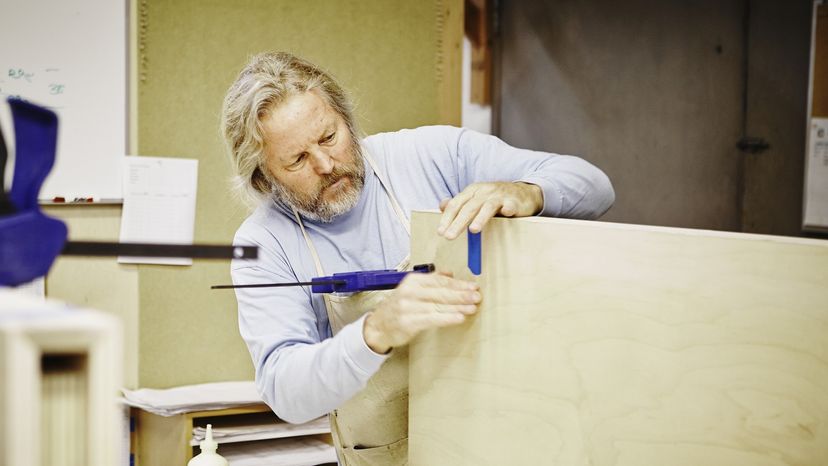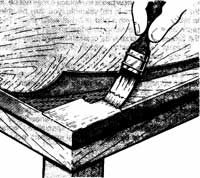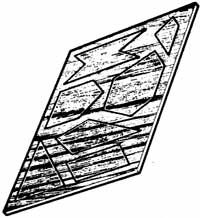
Because veneer is only a thin layer of wood attached with glue to a solid base, it is very vulnerable to damage on wooden furniture. On old furniture, the glue that holds the veneer is often not water-resistant. Prolonged humidity or exposure to water can soften the glue, letting the veneer blister, crack, or peel. Veneer is also easily damaged from the surface, and old veneers are often cracked, buckled, or broken, with chips or entire pieces missing. In this article, we'll discuss basic techniques to repair veneer on your wooden furniture for any at-home furniture refinishing or restoration project.
In most cases, as long as the veneer layer is basically in good shape, the thinness that makes it damage-prone also makes it easy to repair. Undamaged veneer can be reglued; chips and bare spots can be filled with matching veneer. If you're careful to match the grain the repairs will hardly show. Let's get started with the repair techniques by reviewing some common problems, blisters and cracks in veneer.
Advertisement
Blisters
Small blisters in veneer can usually be flattened with heat.
To protect the surface, set a sheet of wax paper and then a sheet of smooth cardboard on the surface, and cover the cardboard with a clean cloth. Press the blistered area firmly with a medium-hot iron. If there are several blisters, move the iron slowly and evenly back and forth. Be careful not to touch the exposed surface with the iron.
Check the surface every few minutes or so as you work, and stop pressing as soon as the blisters have flattened. Leaving the cardboard in place, weight the repair area solidly for 24 hours. Then wax and polish the surface.
Large blisters must usually be slit, because the veneer has swelled. With a sharp craft knife or single-edge razor blade, carefully cut the blister open down the middle, along the grain of the wood. Be careful not to cut into the base wood. Then cover the surface and apply heat as above, checking every few seconds as the glue softens; if the glue has deteriorated and does not soften, carefully scrape it out and insert a little carpenters' glue under the slit edges of the bubble with the tip of the knife.
Be careful not to use too much glue. If necessary, wipe off any excess as the blister flattens. As soon as one edge of the slit bubble overlaps the other, carefully shave off the overlapping edge with a craft knife or razor blade. Heat the blister again; if the edges overlap further, shave the overlapping edge again. When the blister is completely flattened, weight the repair area solidly for 24 hours. Then wax and polish the entire surface.
Loose Veneer
Lifted veneer occurs most often at the corners of tabletops, on cabinet and dresser edges, legs, and drawer fronts. If the loose veneer is undamaged, it can be reglued.

First, remove the residue of old glue left on the back of the veneer and on the base wood. With a sharp craft knife or razor blade, carefully scrape out as much of the old glue as possible. Don't lift the veneer any further; if you bend it up, you'll damage it.
After scraping out as much old glue as you can, clean the bonding surfaces with benzene or naphtha to remove any residue; glue left under the loose area will interfere with the new adhesive. If any glue still remains, sand the bonding surfaces lightly with fine-grit sandpaper, and then wipe them clean with a soft cloth moistened with mineral spirits. If more than one veneer layer is loose, clean each layer the same way.
The veneer can be reattached with contact cement, but you may prefer to use carpenters' glue because it sets more slowly and allows repositioning. To reglue the veneer, apply contact cement to both bonding surfaces and let it set, as directed by the manufacturer. If necessary, set a small tack or two between the layers to keep them from touching. If you'd prefer to use carpenters' glue, use a small brush to spread it along the grain. Then, starting at the solidly attached veneer and working out toward the loose edge, smooth the loose veneer carefully into place.
Contact cement bonds immediately, so make sure the veneer is exactly matched; if you're using carpenters' glue, press from the center out to force out any excess, and wipe the excess off immediately. If more than one veneer layer is loose, work from the bottom up to reglue each layer.
Reglued veneer, whatever adhesive is used, should be clamped or weighted. To protect the surface, cover it with a sheet of wax paper; make sure all excess glue is removed. Set a buffer block of scrap wood over the newly glued area, and use another block or a soft cloth to protect the opposite edge or side of the surface. Clamp the glued and protected surface firmly with C-clamps or hand screws, for one to two days. Then remove the clamps and the buffers, and wax and polish the entire surface.
Cracks, chips, and missing veneer are more extensive damages that require more time and work to repair. Learn some techniques to mend these problems in the next section.
Advertisement

